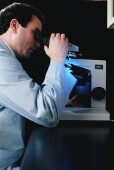
THURSDAY, Jan. 14 (HealthDay News) — Cancer researchers rely on specific tumor cell lines when developing new treatments, but those samples aren’t always what they’re advertised to be, a Dutch team reports.
Their study found that three of 13 human esophageal cancer cell lines widely used for worldwide research were actually cell lines from lung, colorectal and other malignancies.
Two of the contaminated or misidentified cell lines were involved in research published in more than 100 papers and in the issuance of 11 U.S. patents, which led to clinical trials in patients.
One of those trials involved testing the drug Nexavar (sorafenib) on patients with Barrett-related esophageal adenocarcinoma. Nexavar is approved for kidney and liver cancer but not yet for this indication.
While earlier-phase studies using these cell lines are still “scientifically sound,” the clinical trials should be revisited, said Winand N.M. Dinjens, senior author of a short paper published online Jan. 14 in the Journal of the National Cancer Institute and head of molecular diagnostics in the department of pathology at the Josephine Nefkens Institute, University Medical Center Rotterdam in The Netherlands.
“Widespread use of contaminated cell lines threatens the development of treatment strategies for EAC,” he and his colleagues wrote.
Other experts expressed less concern, saying the unintentional misidentification or contamination of the cell lines is not critical and is even a fairly common occurrence.
“From the scientific point of view, it’s not a huge deal, but it’s certainly something you’re glad you found out,” said Charles Saxe, scientific director of the Program in Cancer Cell Biology and Metastasis at the American Cancer Society in Atlanta. “This probably doesn’t surprise anybody. The surprise is probably that there were only three.”
And clinical trials shouldn’t necessarily be stopped, Saxe said, but researchers “need to go back to the other 10 cell lines that are good and see how much of this stuff holds up. They’re not saying pull the plug.”
“The issue of misidentification/crosscontamination is not a new thing,” agreed Robert H. Shoemaker, chief of the screening technologies branch at the U.S. National Cancer Institute and author of an editorial accompanying the study, who also did not deem the finding a huge catastrophe.
Previous estimates gauge that up to one-third of all cell lines have been somehow mischaracterized, the authors stated.
The good news is that advancing technologies will make it easier to identify incorrect cell lines, Saxe stated.
Only 14 cell lines exist for research on esophageal adenocarcinoma which, although not the world’s number-one cancer killer, is increasing sharply in incidence (the authenticity of the 14th line may also be in question). No animal models and few human samples are available for research into the disease, the authors stated, making the existence of such cell lines a critical part of devising new therapies.
So why isn’t this mixup more significant, according to experts?
One reason is that the two signaling pathways looked at in these studies are common to many types of cancer. “Both of those pathways are known to be involved in a very wide number of cancers,” Saxe said. In other words, it’s not inconceivable that research results done in these “bogus” cell lines would be equally valid for esophageal adenocarcinoma.
Paul Sanberg is professor of neurosurgery and director at the University of South Florida Center for Aging and Brain Repair in Tampa. He pointed out that only experimental drugs were tested on this type of cell — not drugs already approved for use with this type of cancer.
But identifying the mistake “sets the stage for seeking targets that are unique to this disease,” Shoemaker said.
The challenge now is to ensure the identities of these cells, experts said.
“These things can happen,” Sanberg said. “This is just more evidence that it’s a good idea to check the characteristics of cells, especially those used in therapeutics.”
More information
The U.S. National Cancer Institute has more on esophageal cancer.

